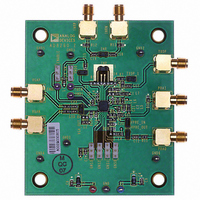AD8260-EVALZ Analog Devices Inc, AD8260-EVALZ Datasheet - Page 21

AD8260-EVALZ
Manufacturer Part Number
AD8260-EVALZ
Description
BOARD EVAL FOR AD8260
Manufacturer
Analog Devices Inc
Specifications of AD8260-EVALZ
Channels Per Ic
1 - Single
Amplifier Type
Variable Gain
Output Type
Differential
Slew Rate
730 V/µs
-3db Bandwidth
195MHz
Current - Output / Channel
310mA
Operating Temperature
-40°C ~ 105°C
Current - Supply (main Ic)
28.3mA
Voltage - Supply, Single/dual (±)
3.3 V ~ 10 V, ±3.3 V ~ 5 V
Board Type
Fully Populated
Utilized Ic / Part
AD8260
Silicon Manufacturer
Analog Devices
Application Sub Type
Programmable Gain Amplifier
Kit Application Type
Amplifier
Silicon Core Number
AD8260
Kit Contents
Board
Lead Free Status / RoHS Status
Lead free / RoHS Compliant
Lead Free Status / RoHS Status
Lead free / RoHS Compliant, Lead free / RoHS Compliant
HIGH CURRENT DRIVER AMPLIFIER
The high current driver amplifier can deliver very large output
currents suitable for driving complex impedances, such as a
power line, a 50 Ω line, or a coaxial cable. The input of the
amplifier is fully differential and intended to be driven by a
differential current-output DAC, as shown in Figure 64. The
differential input signal is amplified by 1.5× and produces a
2.25 V p-p single-ended output signal from a 1.5 V p-p input
signal. A DAC with 15 mA maximum output current into a
50 Ω load provides 1.5 V p-p of input voltage and results in
2.25 V p-p at the output. A DAC whose output is 20 mA produces
an output swing of 3 V p-p (neglecting a small gain error when
driving the parallel combination of the 50 Ω load-resistor and the
internal 1 kΩ gain resistor of the AD8260).
For a 3.3 V supply rail, the maximum limit of the output voltage
is 3 V p-p and distorts severely if exceeded. The recommended
output for optimum distortion is 2 V p-p for a 3.3 V supply.
Correspondingly, larger output swings are accommodated for
higher supply voltages such as +5 V or ±5 V.
1.8V OR 3.3V
FS INPUT
2V p-p
ADC
INN
INP
LOW-PASS
AA FILTER
0V, 1.8V/3.3V
0V, 1.8V/3.3V
0.1µF
0.1µF
3.3V
0.1µF
0.1µF
1.8V OR 3.3V
20mA DAC
VMDO
VNCM
VGAP
VGAN
VPSB
ENBL
TXEN
VMDI
Figure 64. Block Diagram and Basic Application Connections
1
2
3
4
5
6
7
8
VOCM
50Ω
32
9
1.5kΩ
VMID
INPP
3.3V
31
10
0.1µF
1V MAX WITH
200mA pk
1kΩ
Rev. A | Page 21 of 32
30
11
ATTENUATOR
+
GM STAGES
AD8260
29
12
LOGIC
BIAS
1kΩ
GM
0.1µF
28
50Ω
13
For optimum distortion, the input drive must be controlled
such that the output swing is well within saturation levels
established by the supply rail. The output swing can be reduced
by using load resistors with values less than 50 Ω or by reducing
the amplifier gain by connecting external resistors in parallel
with the internal 1 kΩ and 1.5 kΩ resistors between Pin 27,
Pin 28, and Pin 29, and between Pin 30, Pin 31, and Pin 32.
Coincidently, noise is reduced because the gain setting resistors
are the primary noise sources of the high current driver amplifier.
The output-referred noise is 14 nV/√Hz, of which 11 nV/√Hz is
due to the gain setting resistors. Matching of the gain setting
resistors is important for good common-mode rejection and the
accuracy of the differential gain. If external resistors are used,
their accuracy should be at least ±1%. How low the resistor
values can be is primarily determined by the quality of the ac
ground at Pin VOCM; as the gain setting resistors decrease in
value, the dynamic current increases, and the quality of the
decoupling capacitors needs to increase correspondingly.
1.5kΩ
–
C
FB
27
14
OPTIONAL USER SELECTED
C
WITH CAPACITIVE LOADING
FB
26
15
REDUCES HF PEAKING
×1
25
16
24
23
22
21
20
19
18
17
TXOP
TXOP
VPOS
VPOS
VPSR
VMDO
PRAI
FDBK
OPTIONAL CLAMP DIODES
AND SNUBBING RESISTORS
RFB1
RFB2
100Ω
100Ω
3.3V
0.1µF
0.1µF
0.1µF
POWERLINE
CABLE, ETC.
AD8260













